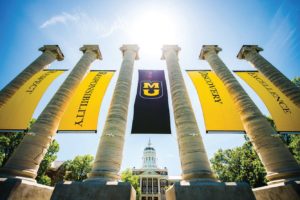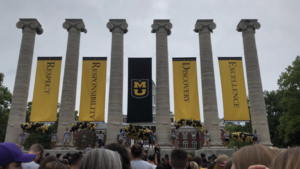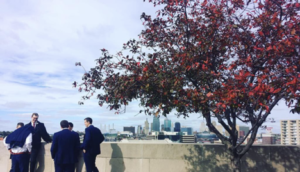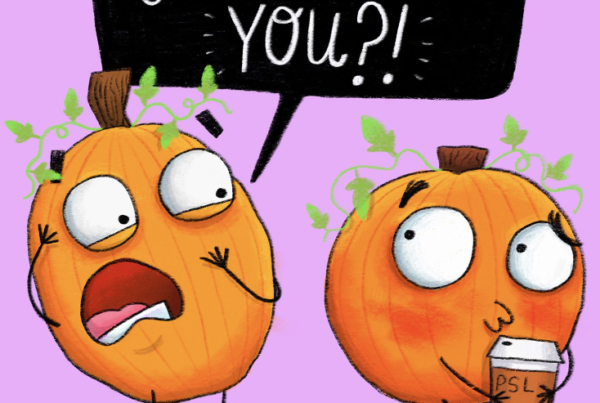
Photo: Shane Epping, University of Missouri, All Rights Reserved, 2016
Interview by Isabel O’Brien
If you, like many other Sciences Pistes, are looking to spend your third year at a top school in the United States, look no farther than Columbia. Columbia, Missouri that is. The Missouri School of Journalism at the University of Missouri was founded in 1908 as the world’s first formal journalism school. Today, it is the number one school for journalism in the United States. The Sundial Press contacted Gaëlle Fournier, a third year Euram student and former Sundial Editor-in-Chief currently studying at Mizzou, to learn more about her year as an exchange student.
Why did you choose Mizzou?
“Five years ago I visited New York City for the first time on a school trip. As I stood outside of the New York Times’ headquarters downtown, I was really motivated to move to the U.S. I knew in that moment that it was my dream to study journalism in America and to eventually work there.
Now, here I am! I chose Mizzou specifically because of its great journalism program. It is actually the only American journalism school which has a partnership with Sciences Po for 3A after the UNC Chapel Hill program was cancelled last year. I knew when I applied that I wanted to be a journalist, so the school’s motto (The Mizzou Method), “Learning by Doing,” really spoke to me. This program is special because it gives you real journalism experience inside and outside the classroom. We’re not just students — we’re journalists, too. For example, it is really common for students to work in local newsrooms during the semester, such as The Columbia Missourian (the local paper) or KOMU8, the regional news station. Right now I’m working at Newsy, which is a cable channel. It has reach to over 50 million people.

Photo: Gaëlle Fournier. The newsroom KOMU8, mid-Missouri’s news leader.
The school presents amazing opportunities to meet journalists from media outlets like The New York Times, The Washington Post, and Fox News. As most of them are former Mizzou students and are more than happy to give conferences.”
Would you recommend it to aspiring 2As?
“I can only speak to the program I am enrolled in, the School of Journalism, which I would definitely, wholeheartedly recommend. The journalism program is also really valued because it is one of the oldest and best in the world. Mizzou itself is great too. It’s a huge school with a lot of internationals, and I definitely feel a part of the whole community. Still, being at the School of Journalism is special because it is its own internal community. You really get to know your fellow classmates well because you have so many classes together. The one class I took outside of journalism was film studies, which was excellent. It reminded me a lot of a course I took at Sciences Po, taught by Sébastien Hubier, “Dream Factory.” But of course, here it is taught in the American way.”
What classes do students have access to in their third year abroad?
“When we arrived on campus, there was an integration week in which professors — who are journalists and producers — came to the school to meet the exchange students and present their classes. As an exchange student, you have access to any class you want within the school. When you first apply, your advisor asks you what classes you’d like to take, and you draft a list. We can really take any class we want since we are considered to be “upperclassmen.” The only classes I found obstacles to taking were those that required prerequisites (previously taken courses)… but I’ll just take them next semester, of course, after I finish the required work.”
How do you find the quality of your classes? How are they different from Sciences Po?
“The classes are extremely different from Sciences Po’s in the sense that they are practical. These classes don’t assign papers — except the non-journalism class — but rather homework based on hands-on experience, such as learning how to use a camera, pitch stories, write for TV, etc. Due to this I’d say that it’s better if you already have had some experience and knowledge about journalism in order to succeed here.
It is the same system in terms of lecturers and labs. For instance, this semester I am taking three journalism classes and one non-journalism class. My journalism classes are: Newsy (the aforementioned cable news channel), a TV broadcast class, and a news writing class. For my TV broadcast class I have three fifty-minutes lectures a week — Monday, Wednesday, and Friday — given by Kellie Stanfield, who is the producer of newscasts at KOMU (the local television station). Attached to that I have a two-hour lab every Wednesday, which is taught by Landon Burke, another journalist and TV news anchor for the morning show at KOMU. All of the teachers are professionals and thus the quality is excellent. All of the students here go on to work for The New York Times, Bloomberg, CNN, The Washington Post, etc. There is also a great atmosphere in the classes, although I am the only international… but this is an asset! Americans are always so happy to meet me.”
What is the workload like?
“We are working hard. It is a lot of work. It is more work than Sciences Po in my opinion because you can’t do everything in advance. Journalism is different from other coursework because you can’t forecast what the news is going to be or guess your next story. You need to be efficient and have the tools to write good stories in a short amount of time. It is not papers and presentations… it is packages, profile assignments, interviewing skills, editing techniques, articles, learning how to anchor, AP style … I like to say that it is an everyday assignment in the sense that our daily work is just as important as our midterms or finals. But this rigor is really important because it is efficient training for how journalism work will be in the field. This fits with the idea that we are not just students, but journalists too.
Even though classes are challenging, the shared passion for the subject of the students on campus makes it so interesting and rewarding. As long as you have passion, you can do anything! Journalism is hard work — you have to knock on doors, cold-call people and really look for your story, even if those around you aren’t cooperating. It’s even harder when you’re not doing it in your native language, but actually this garners even more respect from my peers, who are impressed with my efforts. At first it can be overwhelming, but as the semester passes you know how to work better and faster. Also, I firmly believe that all the work we did at Sciences Po trained us well for this. In the end, there is nothing more satisfying than seeing your own work published — and the students and teachers here are definitely ready to support you along the way.”
What is university life like at Mizzou? What are your favorite parts?
“The university itself is really beautiful. I have two favorite parts: Jesse Hall, which I call “the Capitol” (like in the Hunger Games), is a row of columns in front of the school. They are the only remnants of the university after a fire burned it down in the 1890s. I love the place because it is ancient, like Greek columns, and, in the evenings, it shines in the dark with the American flag waving in the wind. I love walking by.

A picture of the Columns. Photo: Gaëlle Fournier.

Jesse Hall, one of the major symbols of the university. Photo: Gaëlle Fournier.
My other favorite part is Memorial Union, which I call “Hogwarts.” It is a really old building, dating from back when the university was built. It gives me the impression that I am in the middle of a castle.

Memorial Union, one of the most emblematic buildings at Mizzou. Photo: Gaëlle Fournier.
For sports-lovers, Mizzou is a Mecca. MizzouRec has a huge swimming pool and a great sports center. Here you can find an indoor swimming pool with a hot tub, hammam, sauna and an outdoor swimming pool, and there are also dance classes, boxing, cycling, basketball and volleyball courts, a running track, and even places to study! Next to the pool there are indoor trees and tables that are great places to work in between classes.
On the weekends there are lots of house parties, and Greek life is big at the university. During the falls students love to go to (American) football games! I’ve gone many times and have had amazing (and authentically “American”) experiences at the games. Off campus, one nice bar that I’ve found in the city center is called Gunter Hans. It is outdoors and has a nice terrace, lights, and trees — my friends and I love it. Another thing to do on the weekend is go shopping, as we have a mall that is accessible by car… not to mention observing squirrels everywhere on campus!”

A Frat House in Greek Town. Photo: Gaëlle Fournier.

One of Many Football Games! Photo: Gaëlle Fournier.
What are your housing and meal plans like?
“For housing there are two choices: on or off campus. If you live on campus, you are in a dorm. You can choose to have a roommate but I consider either choice to be expensive (perhaps around $900 a month). I myself live off campus, in a really nice place called “Rise on 9th.” It is a new building built just two years ago, so it’s super modern and nice. It’s similar to Residium or Quai 207 in Reims in the sense that it is privately owned and only students live in the building. The big differences, however, are a) you can choose to live with up to three roommates, and b) there is, sadly, no CAF. Therefore, I’d say it is a bit more expensive to live in Columbia than Reims. I do admit, though, that my apartment here is much nicer than the student residences of Reims — here I have a huge TV, a dishwasher, a gym, a swimming pool, a billiards table, a washer, a dryer, a couch, a table, an entirely fitted kitchen, and even my bathroom has a bluetooth speaker! You really have everything. The top two floors of the building also offer private study rooms, lounges, and a 360 degree view of the city through glass windows.
In terms of meal plans, I opted for a “Tiger plan” (named after the school mascot, the Tigers), which means that I get $825 on my student card each semester to buy food at on-campus food facilities and dining halls. I also get a a 63% discount on everything I buy, which is super practical. I really like this plan because I live off campus, and I don’t always have time to go the dining hall, so I have more flexibility at non-dining hall facilities.
When I cook for myself, I go to Lucky’s Market, which is a fifteen minute walk from my place. It sells organic food, good quality, at Carrefour City prices. There are so many choices so it’s a good place to go. Besides, the only other choice (Walmart) is quite far so you have to go by car.”
How is the city, Columbia?
“The town itself is pretty, small, about the same size as Reims. The only difference is that Columbia, unlike Reims, is a college town. Here the university is the biggest part of the city and everyone around you is so proud of it, especially the School of Journalism. Another great thing about the city is the fact that it is in the middle of nature… there are so many trees, cliffs, parks, and, especially during this time of year, colorful foliage. The area around the university is really great for hiking.

Columbia During Autumn. Photo: Gaëlle Fournier.
Downtown there are two main shopping streets and a movie theater called RagTag Cinema, which only shows non-mainstream movies. Better yet, there is a bakery that sells baguettes inside, so I get my fix!”
Many people may not know that Mizzou offers one of the top journalism programs in America. What advice would you have for Sciences Po students who might be wary of attending the school because of its name or location?
“Americans here are always so shocked that I, a French girl, would come to “the middle of nowhere” in America for my exchange. Why not go somewhere more exciting, like New York? What I have to say to that is that even though Columbia may not be a world renowned city, there are so many benefits to living here. First of all, I am truly getting to experience real American culture. Secondly, it is not impossible to travel around. For instance, Kansas City is just two hours from Columbia by car. I went, and I think it’s a great city — there are fountains, shopping, and skyscrapers.

Kansas City, a Great Weekend Trip! Photo: Gaëlle Fournier.
Another location that is accessible is St. Louis. I went there to see an Ed Sheeran concert this summer and it was great. Chicago is also not far by plane… about one hour from Columbia’s regional airport. I plan on going soon, at the end of November
For anyone considering it, I would just like to say that the School of Journalism at Mizzou has been an incredible experience so far. Every day is like living a dream — the things I’m learning, the people I’m meeting, the teachers I’m having, everything is so stimulating. I am so grateful that Sciences Po offered me this opportunity to study something that I am so passionate about. It has only been three months but I’ve grown so much, and I’ve truly confirmed my passion for journalism. I’m sure I will be back in the U.S. in the future to put what I’ve learned here into practice!”
—
While world-class academics and sprawling metropolises may not come to mind when you think of Missouri, don’t be deceived — Mizzou has all of that and more to offer! If you’re looking to broaden your horizons and get the true “American College” experience, follow in Gaëlle’s footsteps: consider the Missouri School of Journalism!
Cover Photo: Shane Epping, University of Missouri, All Rights Reserved, 2016
Other posts that may interest you:
- The Trouble with ‘Ecocide’
- Carbon dioxide removal – hit or miss?
- Local Victories for Turkish Opposition — A Sign of Hope?
- Are France and Japan a Mismatch Made in Heaven?
- A Reflection on Dark Tourism
Discover more from The Sundial Press
Subscribe to get the latest posts sent to your email.




